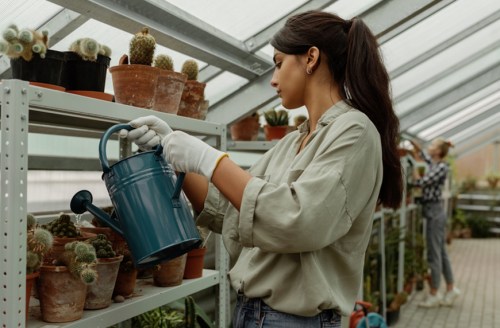Buying plants is easy—the tricky part is keeping them alive once you do. For a while, your new green friends might thrive just as much as you are. But only takes a few common mistakes to make a once-healthy plant take a turn for the worse as it succumbs to wilting, drying out, or yellowing.
The good news is there are some simple tips you can use to keep your little green guys growing strong. And who better to get advice from the plant experts who aren’t just proud owners of green thumbs, but also live and breathe plants all day long at work.
How to keep plants alive, according to a professional gardener
1. Water deeply instead of lightly and frequently
When it comes to watering your houseplants, Susan Spanger, professional gardener and floral designer of Bloomful Floral Design, says it’s best to water them deeply rather than lightly and frequently. “If only the top roots are receiving adequate water, the plant isn’t getting the right kind of fuel it needs to survive. Most of the plant’s roots have worked their way down into the soil, in search of nutrients and water,” she says. “I often tell my customers to wait until the soil begins to dry out. Stick your finger an inch into the soil and check back in a day or two if you detect dampness. Then, use a slow-draining watering can with room temperature water and watch for when the water isn’t draining through the soil anymore. That’s your signal to stop watering.”
2. Pick a plant to match the level of light in your space
The key in keeping your plants alive is only getting the plants that will thrive with the amount of light you can provide in your home. While snake plants, Monsteras, corn plants, and spider plants do well in low light, jade plants, rubber plants, and fiddle-leaf figs do best in brighter spots.
“If you’re not sure which type of light you have just by looking, start by figuring out which direction your windows face—south-facing windows are the best. Then check if there’s anything right outside that could block some of that natural sunlight that could stream in,” says Erin Marino, plant expert and director of marketing at The Sill. “Keep it simple and decide first: Is the light direct or indirect? Then, if it’s indirect: Is it bright, medium, or low? Once you narrow it down, it’ll be much easier to choose the best plant varieties for your space.”
3. Don’t forget about humidity
If your tropical plants aren’t doing well in your indoor space, there’s a reason for that. “To mirror the natural environment of tropical regions, you must factor in humidity for the best indoor growing conditions,” says Spanger. “Plants such as cacti and the ever-popular succulents can tolerate lower levels of humidity. The majority of houseplants will thrive when the relative humidity is kept at fifty percent or higher. To combat indoor dryness, you can occasionally turn on a humidifier near your plants or bring them into the bathroom when you shower and left them hang out there for the remainder of the day.”
For moisture-loving plants, Spanger says you can use moss. “A favorite finishing material among professionals is live moss, which some of us even grow in our greenhouses. On your next nature walk in the woods, look and see if you can find a few strips of sphagnum moss, which lifts easily from moist ground. Take it home and tuck it around your orchid or bromeliad and watch it thrive,” she says. You can also steal a trick from her dad: “My father has the greenest of thumbs, and his secret is to set his smaller plants on shallow trays of moistened gravel to raise humidity,” she adds.
4. Keep your Plant’s environment as stable as possible
You and your houseplants have more in common than you think, because they like stability just as much as the next girl. “Most houseplants, just like us, are most comfortable between 65°F to 80°F. Extreme cold or hot fluctuations in temps can stress them out,” says Marino. “Do your best to avoid placing plants near temperature hazards like vents, radiators, and exterior doors or open windows, which might create hot or cold drafts of air.”
Sorry, your houseplants aren’t cleaning the air in your home. Here’s what you should know. Then find out the easy mistake most people make when it comes to caring for air plants.
Sign Up for Our Daily Newsletter
Get all the latest in wellness, trends, food, fitness, beauty, and more delivered right to your inbox.
Got it, you've been added to our email list.










